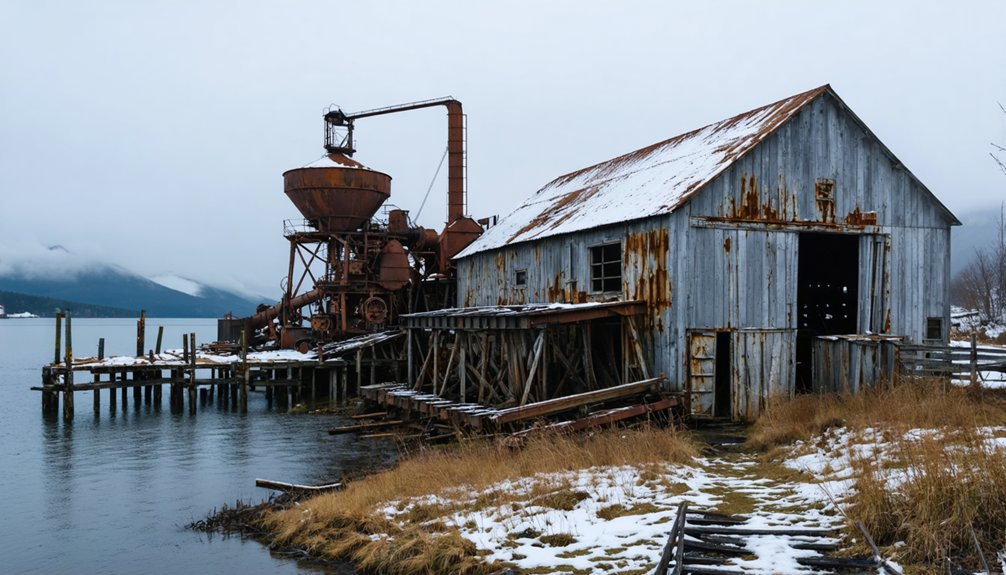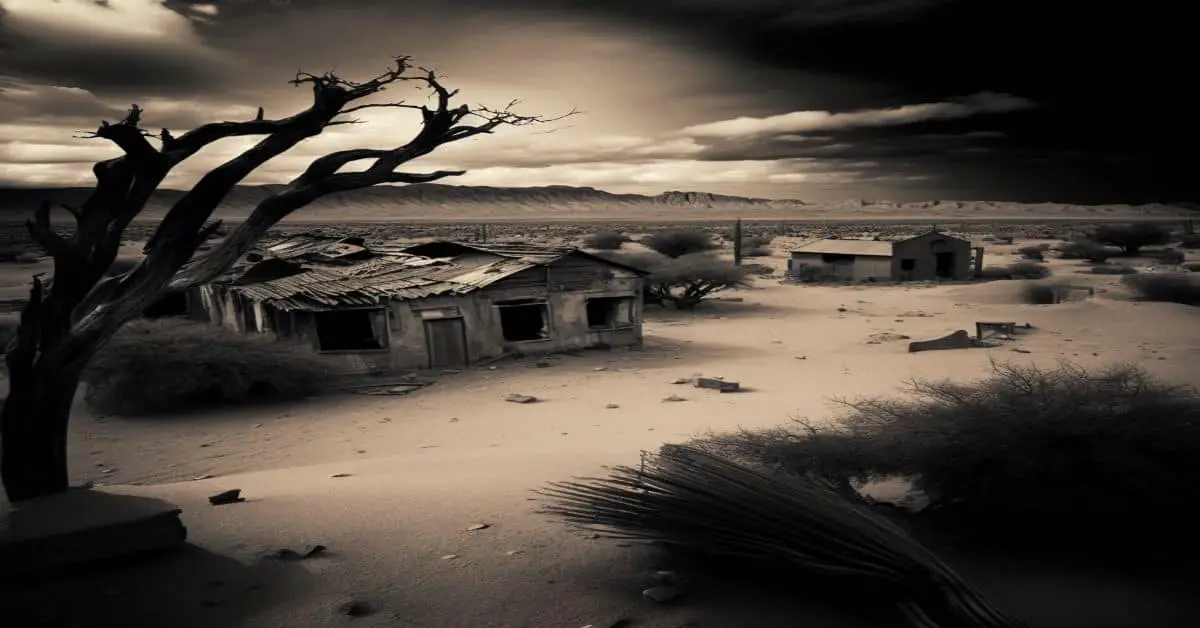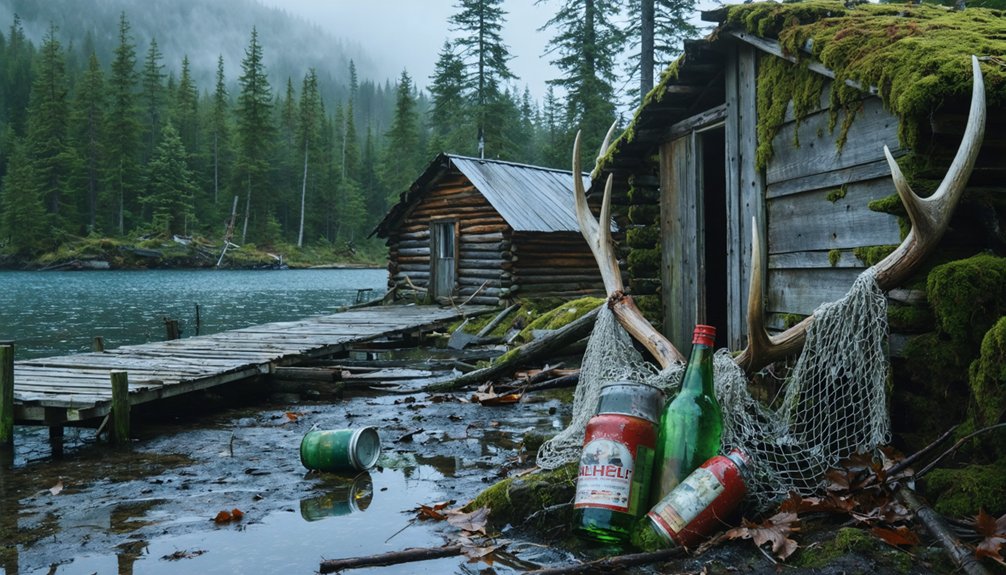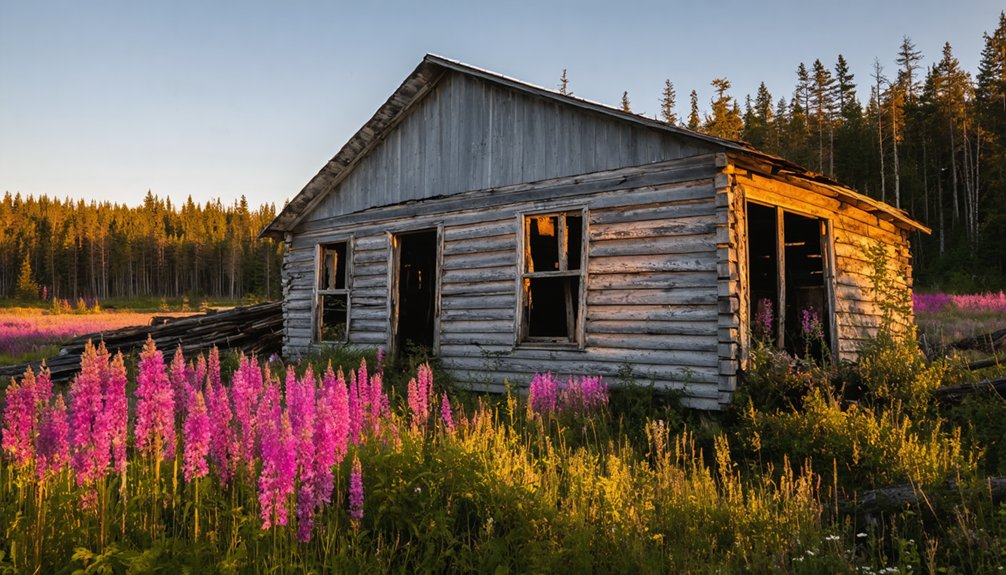You’ll find Cape York’s remnants along Alaska’s western coast, where gold’s discovery in 1896 transformed this harsh frontier into a bustling 1,200-person settlement. The town flourished with trading posts, saloons, and mining operations until the 1920s, when dwindling gold yields triggered its decline. By 1935, the last residents had departed, leaving behind weather-beaten cabins, rusted mining equipment, and artifacts that tell a compelling story of Arctic survival and frontier resilience.
Key Takeaways
- Cape York transformed from a thriving gold rush settlement in 1896 to a ghost town by 1930 after mining operations failed.
- The settlement peaked with several hundred residents including Americans, Europeans, and Indigenous peoples during the gold rush era.
- Harsh Arctic conditions with -40°F temperatures and polar nights contributed to the town’s eventual abandonment.
- Original wooden cabins, mining equipment, and domestic artifacts remain as historical markers of frontier life.
- The site now serves as an educational resource, showcasing the boom-and-bust cycle of Arctic frontier settlements.
The Rise of a Gold Rush Settlement
When gold was discovered near Cape York in 1896-1897, this remote section of Alaska’s Seward Peninsula transformed from an isolated frontier into a bustling mining settlement.
Word of the gold discovery spread quickly to Nome, drawing prospectors who braved the harsh subarctic conditions to stake their claims in the unforgiving landscape.
You’ll find that these early pioneers faced challenging prospecting obstacles as they established temporary camps that eventually grew into more permanent structures.
They built wooden cabins, trading posts, and essential infrastructure while dealing with brutal winters and limited resources.
The settlement’s population swelled from just dozens to several hundred as Americans, Europeans, and some Indigenous peoples arrived seeking their fortunes.
Despite the isolation, they created a determined community complete with basic services, mail delivery, and the social comforts of saloons and general stores.
Life on Alaska’s Western Edge
If you’d journeyed to Cape York’s western edge in the early 1900s, you’d have encountered settlers battling temperatures that plummeted to -40°F while living in structures built to withstand both permafrost and coastal storms.
Your survival would’ve depended on adopting indigenous techniques for food preservation, including smoke-drying fish and storing whale blubber in permafrost cellars.
The few remaining artifacts from this period – including ice saws, modified fishing equipment, and fortified cabin foundations – showcase how residents adapted their gold rush equipment for Arctic coastal living.
Harsh Arctic Living Conditions
Located on Alaska’s rugged western edge, Cape York‘s harsh Arctic conditions presented residents with extraordinary survival challenges throughout its inhabited years.
You’d face winter temperatures plunging to -40°F, while fierce blizzards could trap you indoors for days. Arctic survival meant adapting to less than four hours of daylight during winter months, and winds exceeding 30 mph made every outdoor task treacherous.
The extreme temperatures shaped daily life, forcing residents to build homes on stilts to prevent permafrost damage. You couldn’t grow food in the frozen ground, so hunting and fishing became essential.
When supply planes couldn’t land during storms, you’d rely on stored provisions. Without road access, the community depended entirely on air transport and seasonal ice roads, making every supply run a calculated risk.
Coastal Survival Methods
Through generations of coastal adaptation, Cape York’s residents developed sophisticated survival methods uniquely suited to Alaska’s western shoreline.
You’d find their shelters strategically positioned near fresh water and natural windbreaks, with entrances facing away from harsh winds. They’d construct semi-subterranean dwellings using sod, timber, and animal skins for ideal insulation.
Their coastal foraging focused on salmon fishing, seal hunting, and gathering seasonal berries and seaweed. Traditional preservation techniques – smoking, drying, and freezing – enabled food storage through winter in carefully positioned caches.
They’d navigate the coastline in kayaks and umiaks, relying on intimate knowledge of tides and currents. Their waterproof clothing, crafted from seal intestines and caribou hide, incorporated sophisticated ventilation systems to prevent deadly sweat accumulation in the harsh Arctic environment.
Mining Operations and Economic Prosperity
Gold’s discovery in Cape York during the early 1900s released a surge of mining activity that transformed the remote region into a bustling frontier settlement.
You’d have found prospectors using basic mining techniques like panning and sluicing along the streams, later upgrading to steam-powered equipment and dredges to improve their yields. The harsh arctic climate dictated seasonal operations, while the challenging terrain limited hard rock mining possibilities.
Economic fluctuations marked the town’s prosperity as mineral yields varied and transportation challenges persisted. While trading posts and supply stores flourished temporarily, the depletion of accessible gold deposits by mid-century led to the town’s decline.
Today, you’ll find only remnants of mining infrastructure scattered across the landscape, silent witnesses to Cape York’s brief but vibrant mining era.
Daily Challenges in the Arctic Frontier
Beyond the challenges of mining operations, daily life in Cape York tested the limits of human endurance.
You’d face brutal winters with temperatures plummeting to -50°F, while polar nights shrouded the settlement in darkness for months. Resource management became a critical survival skill as you’d need to stockpile fuel, preserve food, and carefully ration freshwater when sources froze.
The isolation took its toll on mental health, as you’d cope with limited social interaction and minimal communication infrastructure. You’d rely on satellite phones and radios to maintain contact with the outside world.
The harsh environment demanded constant vigilance – from avoiding polar bear encounters to protecting against frostbite. Weather-dependent supply deliveries meant you’d often face shortages, while medical emergencies required complex air evacuation procedures.
Cultural Exchanges and Community Dynamics
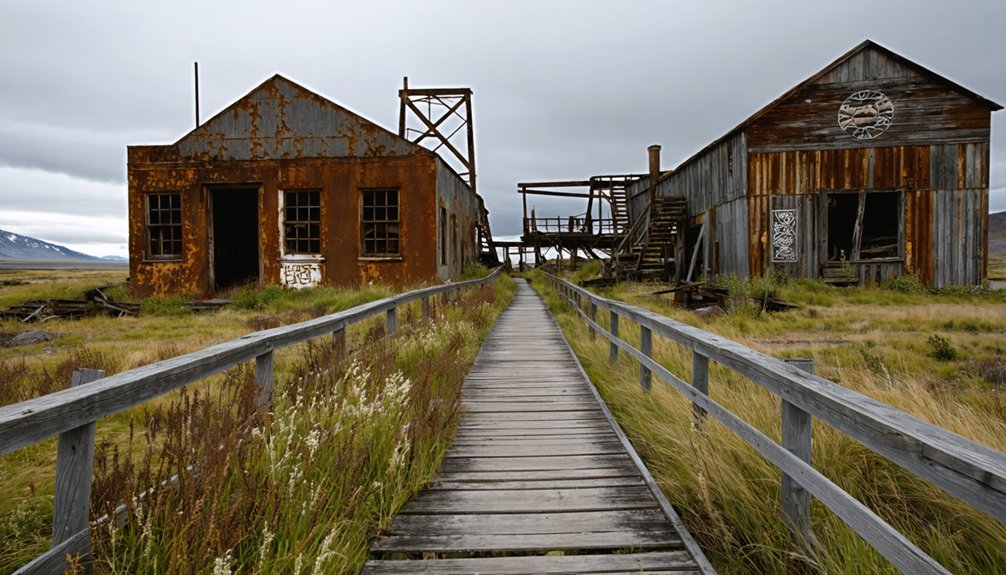
While mining drove Cape York’s economic engine, the settlement’s cultural fabric wove together diverse threads of humanity in fascinating ways.
You’d have witnessed cultural resilience in action as Iñupiat peoples maintained their traditions while adapting to newcomers. The community’s social interdependence emerged through necessity – settlers learned Arctic survival from Indigenous neighbors, while Iñupiat traders exchanged furs and food with miners.
Despite language barriers, you’d have seen a vibrant exchange of survival techniques, with settlers adopting sled dog transportation and ice fishing methods.
Survival transcended language as newcomers embraced Indigenous wisdom, mastering Arctic ways through sled dogs and ice fishing techniques.
Festivals brought both groups together, though infrequently. Trade networks stretched beyond Cape York to Nome, creating a web of relationships that sustained the remote settlement.
Multiple languages filled the air: Iñupiaq alongside English and European tongues, reflecting the settlement’s unique multicultural character.
The Decline and Abandonment
If you’d visited Cape York’s mines in the early 1920s, you’d have witnessed the final gasps of what was once a thriving mineral extraction operation, as depleted resources forced widespread closures and left mining equipment frozen in time.
The exodus began with the miners and their families, who departed en masse as the Great Depression compounded the region’s economic woes throughout the 1930s.
Mining Boom’s Final Days
As global gold prices fluctuated in the early 20th century, Cape York’s once-thriving mining operations began their inevitable descent into abandonment.
You’ll find that diminishing economic incentives and outdated mining techniques spelled disaster for the remote settlement. The harsh Arctic climate made deeper excavations increasingly dangerous, while depleted gold veins yielded less and less return.
Transportation challenges mounted as infrastructure crumbled, and you can still see remnants of the deteriorating supply routes that once sustained the community.
When nearby processing mills closed, miners faced impossible odds. The final blow came as government regulations tightened and taxation increased. Workers departed in waves, seeking opportunities elsewhere, leaving behind their homes and dreams.
The once-bustling mining town gradually surrendered to silence, its buildings standing as silent witnesses to the end of an era.
Population Exodus Patterns
Once the mining operations faltered in Cape York, you’d have witnessed a methodical unraveling of the town’s social fabric between 1920-1935.
The migration trends followed a predictable pattern: young families departed first, seeking education and opportunities elsewhere. Next, working-age adults left as jobs disappeared and services dwindled.
The population decline accelerated when the postal service ended and medical facilities closed. You’d have seen community gatherings become sparse, then cease altogether.
By 1930, only elderly residents remained, clutching to their properties until harsh winters and isolation forced their retreat. The final exodus came as utility systems failed and transportation links were severed.
Wildlife reclaimed the streets, and the permafrost’s destructive force began dismantling the town’s remaining structures.
Surviving Structures and Artifacts
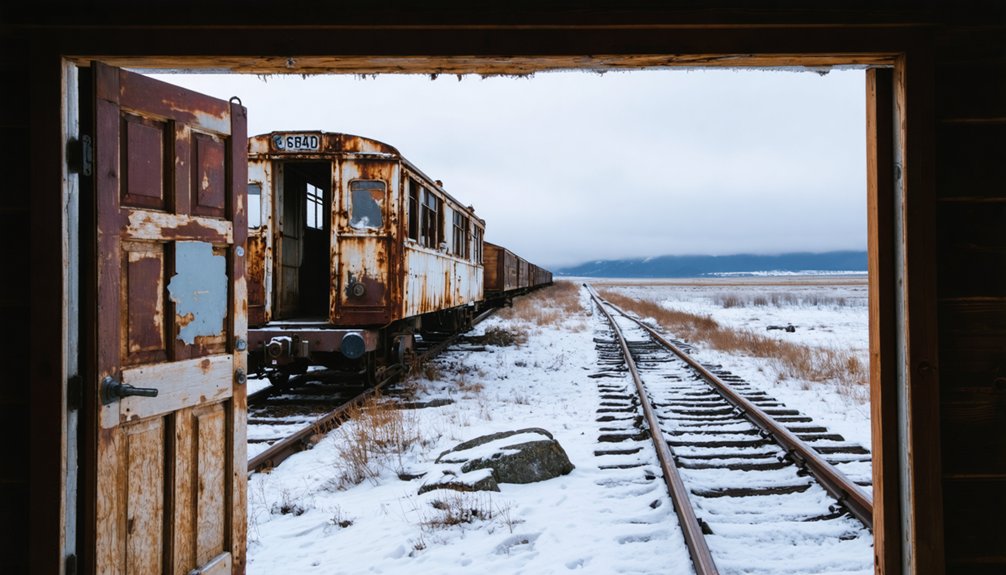
The scattered remnants of Cape York’s frontier existence tell a compelling story of early 20th-century Alaskan life.
As you explore the site today, you’ll find surviving structures and historical artifacts that paint a vivid picture of this rugged mining settlement. Original wooden cabins stand alongside stone chimneys, while the old timber dock reaches into the water, marking where supplies once arrived.
- Corroded mining equipment and ore cart rails reveal the town’s gold-seeking heritage
- Broken glass bottles, ceramic fragments, and cast iron stoves showcase domestic life
- Transportation relics include wagon planks, horseshoes, and early motor vehicle parts
- Communication artifacts feature glass insulators from telegraph lines
- Daily life items such as leather shoes, tin cans, and handwritten notes offer glimpses into frontier living
Weather’s Impact on Town Preservation
While weather-beaten structures still stand at Cape York, harsh environmental conditions pose a constant threat to their survival.
You’ll find that the region’s extreme weather patterns, combining bitter cold and heavy precipitation, accelerate the decay of remaining buildings. The seasonal fluctuations cause materials to expand and contract, gradually weakening structural integrity.
The site’s remote location makes preservation particularly challenging, as you’d need to transport maintenance materials across difficult terrain.
The permafrost beneath the buildings shifts with temperature changes, destabilizing foundations. In winter months, limited sunlight increases moisture retention, leading to faster deterioration.
Snow and ice accumulation puts additional stress on aging roofs and walls. Without consistent maintenance efforts, these environmental forces continue to erode Cape York’s historical structures year after year.
Historical Legacy and Modern Significance
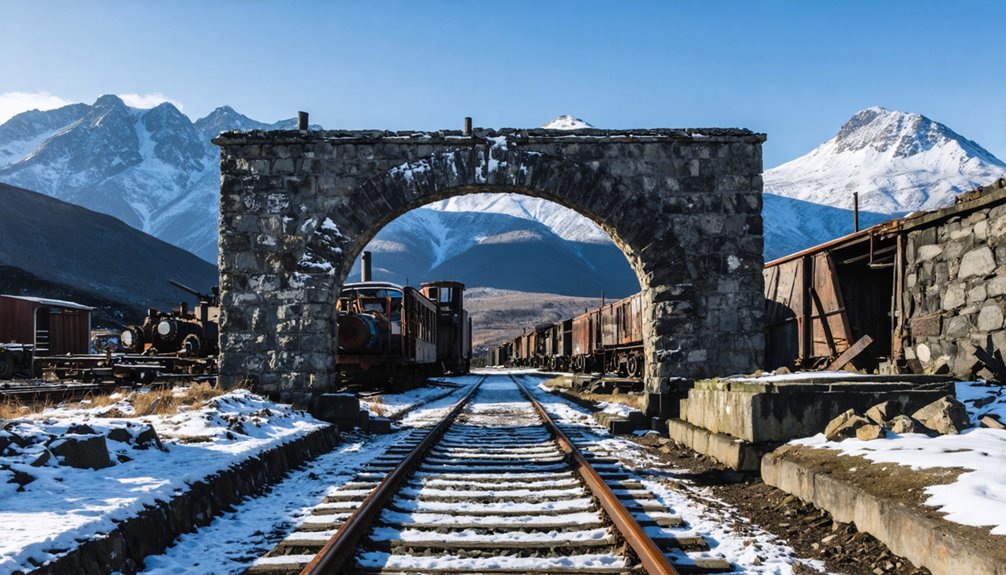
Beyond weathering and decay, Cape York’s enduring historical value emerges through its rich tapestry of artifacts and structures spanning multiple eras.
You’ll discover a reflection of economic volatility and frontier resilience in this remote Alaskan settlement, where historical significance radiates from every abandoned building and rusted mining tool.
- Mining equipment and household items tell the story of a once-thriving 1,200-person community
- Military installations from WWII and Cold War periods showcase strategic importance
- Indigenous construction techniques in remaining structures reveal cultural exchange
- Digital preservation efforts capture the site’s legacy using modern technology
- Archaeological surveys since the 1980s continue documenting this slice of frontier life
Today, you’re witnessing Cape York’s transformation from a bustling gold rush town to an educational treasure, where each artifact tells a unique story of Arctic settlement and human perseverance.
Frequently Asked Questions
Were There Any Major Crimes or Lawlessness Reported During Cape York’s Peak?
You’ll find crime trends were minimal, with only minor theft and alcohol disputes reported. Military presence served as law enforcement, preventing major lawlessness during the site’s wartime and mining operations.
What Happened to the Native Alaskan Trading Posts After the Town’s Abandonment?
You’ll find the trading post decline led to widespread closures, leaving only remnants and artifacts. Local communities worked to preserve native heritage through historical documentation and conversion of sites into cultural landmarks.
Did Any Famous Historical Figures Ever Visit Cape York?
Prominent pioneers and prospectors made exploratory visits, though historical accounts don’t definitively document famous figures at this location. You’ll find records mostly mention local miners and traders passing through.
How Did Mail Delivery Operate in Such a Remote Location?
You’d have found mail reaching you via dog sleds in winter and boats in summer, traversing treacherous mail routes. Local native carriers braved extreme weather, wildlife, and delivery challenges to maintain essential connections.
Were There Any Documented Shipwrecks Near Cape York’s Coast?
You’ll find few documented shipwrecks here, though local shipwreck legends persist. Maritime archaeology efforts remain limited due to harsh conditions and remote access, leaving potential discoveries beneath the icy waters unexplored.
